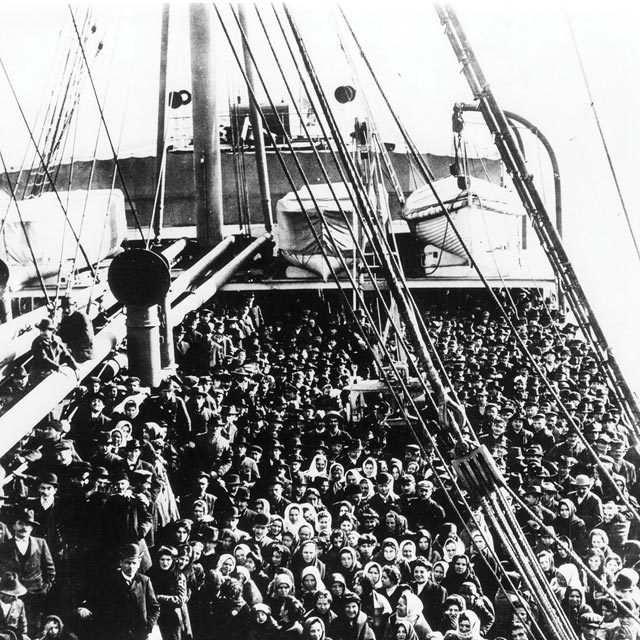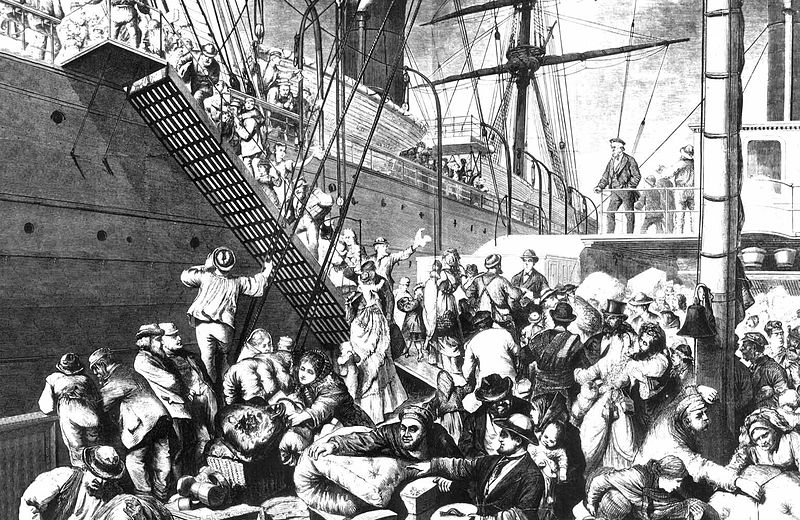Swedish Emigration to the United States
A variety of factors in Sweden led to the beginning of mass emigration in the 19th century.
-
 Illustration of European emigration of the 19th century. Source unknown.
Illustration of European emigration of the 19th century. Source unknown. -
-
From 1860 to 1920 1,3 million people emigrated from Sweden to the United States. Sweden´s population at the end of the 19th Century was 5,1 million. Thus, nearly 25 % of the Swedish population left. What were the factors that prompted such a mass exodus?
-
 Sketch of European emigrants boarding a steamer in Hamburg, Germany, to relocate in America, published in Harper's Weekly, November 7, 1874.
Sketch of European emigrants boarding a steamer in Hamburg, Germany, to relocate in America, published in Harper's Weekly, November 7, 1874. -
-
Sweden was until 1865 a country ruled as a Feudal hierarchic class society. There were four "Classes", the aristocracy, the clergy, the business people and tradesmen of the cities, and the farmers in the countryside. Of these, only the farmers who owned their own land, had any civic rights at all. The rest, the poor and the women, lived in appalling conditions of poverty and squalor. Moving from the class into which you were born was virtually impossible. The duties and rights of the different classes were very well defined in the law. The aristocracy did not have to pay property or land taxes, and they had exclusive rights to higher civil and military positions.
The clergy controlled education. They had the right to be paid a tenth of what people earned.
The trades/business men of the cities had exclusive rights to be merchants and craftsmen. You were not allowed to produce things in the countryside. Exceptions were very rare. Mills, sawmills, tanneries and other small industry necessary for farming, were occasionally granted permission to exist.
Farmers who owned their own land, a minority of the rural population, had representative rights.
The great majority, however, were subjected to other rules. They had to earn their living slaving for little and no pay on farms, as workers of different categories. They could be expelled at any moment, and working hours were non-existent.
Soldiers were allowed to live in little cottages, but had to report for duty in the army whenever necessary.
Women, unless they were married or widows,had next to no rights at all.
Sick and poor people were auctioned out to the farms where they were expected to do simple tasks. They were totally dependent on people´s benevolence.There were poor houses in some villages. In Kisa one was built in 1742.
Some rich people with a conscience donated money to the poor, but they were under no obligation to do so. -
In 1638, a Swedish Colony had been established on the Delaware River, called New Sweden. The Dutch took it over in 1655. The greatest significance of New Sweden was the strong and long-lasting interest that the colony generated in Sweden. America was seen as the standard-bearer of enlightenment and freedom; America became the symbol and dream of unfettered individualism. But only handful of liberally-minded people knew anything about this. Very few Swedes had any personal experience of America. Emigration was illegal..
-
Due to changes in society, such as better food and no wars, the Swedish population doubled between 1750 and 1850, and overpopulation outstripped economic development. There were too many people, not enough land and not enough work to feed them In the 1830s the laws against emigration were repealed. Now the doors to mass emigration were open.
Also, religious repression by the Swedish Lutheran State Church caused resentment among many people In the late 1840s, 1500 followers of Erik Jansson left and founded a community in Bishop Hill, Illinois, after having been harassed by the Church. -
Repeatedly failing crops made condition in the Swedish countryside increasingly bleaker than ever in the middle of the 19th century. Reports from early Swedish emigrants painted the American Midwest as an earthly paradise, and praised American religious and political freedom and undreamed-of opportunities.
Large-scale European emigration to the United States started in Great Britain, Ireland and Germany in the 19th century, followed by a rising wave after 1850 from most North European countries. Nordic mass emigration started in Norway, which retained the highest rate throughout the century. Sweden got underway in the early 1840s and had the third-highest rate of all of Europe after Ireland and Norway.
-
The Swedish establishment disapproved intensely of emigration. It was seen as depleting the labor force and as a defiant act among the lower orders. Emigration alarmed both the spiritual and the secular authorities. The local clergy warns travellers against risking their souls among foreign heretics. The conservative press described emigrants as lacking in patriotism and moral fibre."No workers are more lazy, immoral than those who emigrate to other places" The liberal press retorted that those who opposed emigration failed to take into account the miserable conditions in the Swedish countryside and the backwardness of Swedish economic and political institutions. Emigration had been called a "mania. Yes, emigration is indeed a "mania, wrote the liberal Göteborgs Handels.och Sjöfartstidning, "The mania of wanting to eat one´s fill after one has worked oneself hungry. The craze of wanting to support oneself and one´s family in an honest manner."
-
Emigration was also helped by new means of transport. The first European emigrants travelled in the holds of sailing cargo ships. With the advent of the age of steam, an efficient transatlantic passenger transport mechanism was established at the end of the 1870s. The majority of Swedish emigrants travelled from Göteborg to Hull, and then by train to Liverpool and over to America by big transatlantic ships.
-
In the south-east of Sweden, in the stony and unforgiving province of Småland, and its neighbouring regions, like Kinda, rural conditions were especially bleak, and this became the heartland of emigration. "The American Midwest is an agrarian antipode to Småland", reported one early settler, a university graduate called Unonius from Uppsala, who had left in 1841, "as it more closely than any other country in the world approaches the ideal which nature seems to have intended for the happiness and comfort of humanity". The inexpensive and fertile land of Illinois, Iowa, Minnesota and Wisconsin was irresistible to. well-established farmers as well as to landless and impoverished European peasants.
-
-
